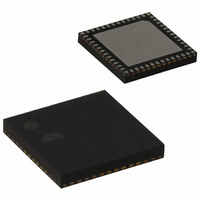EM357-RTR Ember, EM357-RTR Datasheet - Page 40

EM357-RTR
Manufacturer Part Number
EM357-RTR
Description
IC RF TXRX ZIGBEE 192KB 48QFN
Manufacturer
Ember
Specifications of EM357-RTR
Frequency
2.4GHz
Data Rate - Maximum
250kbps
Modulation Or Protocol
802.15.4 Zigbee
Applications
General Purpose
Power - Output
5dBm
Sensitivity
-100dBm
Voltage - Supply
2.1 V ~ 3.6 V
Current - Receiving
26mA
Current - Transmitting
31mA
Data Interface
PCB, Surface Mount
Memory Size
192kB Flash, 12kB RAM
Antenna Connector
PCB, Surface Mount
Operating Temperature
-40°C ~ 85°C
Package / Case
48-QFN
Lead Free Status / RoHS Status
Lead free / RoHS Compliant
Other names
636-1011-2
Available stocks
Company
Part Number
Manufacturer
Quantity
Price
Company:
Part Number:
EM357-RTR
Manufacturer:
SILICON
Quantity:
3 000
Part Number:
EM357-RTR
Manufacturer:
SILICON
Quantity:
20 000
- Current page: 40 of 245
- Download datasheet (12Mb)
6.1
Power domains
The EM35x contains three power domains:
6.1.1
The preferred and recommended power configuration is to use the internal regulated power supplies to
provide power to the core and memory domains. The internal regulators (VREG_1V25 and VREG_1V8) generate
nominal 1.25 V and 1.8 V supplies. The 1.25 V supply is internally routed to the core domain and to an
external pin. The 1.8 V supply is routed to an external pin where it can be externally routed back into the chip
to supply the memory domain. The internal regulators are described in Chapter 16, Integrated Voltage
Regulator.
When using the internal regulators, the always-on domain must be powered between 2.1 V and 3.6 V at all
four VDD_PADS pins.
When using the internal regulators, the VREG_1V8 regulator output pin (VREG_OUT) must be connected to the
VDD_MEM, VDD_PADSA, VDD_VCO, VDD_RF, VDD_IF, VDD_PRE, and VDD_SYNTH pins.
When using the internal regulators, the VREG_1V25 regulator output and supply requires a connection
between both VDD_CORE pins.
6.1.2
Optionally, the on-chip regulators may be left unused, and the core and memory domains may instead be
powered from external supplies. For simplicity, the voltage for the core domain can be raised to nominal
1.8 V, requiring only one external regulator, or the core domain can be powered from the on-chip regulators
while the other domains are powered externally. Note that if the core domain is powered at a higher voltage
(1.8 V instead of 1.25 V) then power consumption increases. A regulator enable signal, REG_EN, is provided for
control of external regulators. This is an open-drain signal that requires an external pull-up resistor. If REG_EN
is not required to control external regulators it can be disabled (see section 7.3, Forced Functions in Chapter
7, GPIO).
Using an external regulator requires the always-on domain to be powered between 1.8 V and 3.6 V at all four
VDD_PADS pins.
When using an external regulator, the VREG_1V8 regulator output pin (VREG_OUT) must be left unconnected.
When using an external regulator, this external nominal 1.8 V supply has to be connected to both VDD_CORE
pins and to the VDD_MEM, VDD_PADSA, VDD_VCO, VDD_RF, VDD_IF, VDD_PRE and VDD_SYNTH pins.
An “always-on domain” containing all logic and analog cells required to manage the EM35x’s power modes,
including the GPIO controller and sleep timer. This domain must remain powered.
A “core domain” containing the CPU, Nested Vectored Interrupt Controller (NVIC), and peripherals. To
save power, this domain can be powered down using a mode called deep sleep.
A “memory domain” containing the RAM and flash memories. This domain is managed by the power
management controller. When in deep sleep, the RAM portion of this domain is powered from the always-
on domain supply to retain the RAM contents while the regulators are disabled. During deep sleep the flash
portion is completely powered down.
Internally regulated power
Externally regulated power
Final
6-2
EM351 / EM357
120-035X-000G
Related parts for EM357-RTR
Image
Part Number
Description
Manufacturer
Datasheet
Request
R

Part Number:
Description:
MODULE EM357 PA/LNA W/ANT TG
Manufacturer:
Ember
Datasheet:

Part Number:
Description:
MODULE EM357 NO PA/LNA W/ANT TG
Manufacturer:
Ember
Datasheet:

Part Number:
Description:
MODULE EM357 NO PA/LNA W/RF CONN
Manufacturer:
Ember
Datasheet:

Part Number:
Description:
MODULE EM357 PA/LNA W/RF CONN
Manufacturer:
Ember
Datasheet:

Part Number:
Description:
IC RF TXRX ZIGBEE 192KB 48QFN
Manufacturer:
Ember
Datasheet:

Part Number:
Description:
KIT DEV EMBER ZIGBEE W/PCWH
Manufacturer:
Custom Computer Services Inc (CCS)

Part Number:
Description:
PROGRAMMER USB FLASH EM250/260
Manufacturer:
Ember
Datasheet:

Part Number:
Description:
IC ZIGBEE SYSTEM-ON-CHIP 40-QFN
Manufacturer:
Ember
Datasheet:

Part Number:
Description:
IC ZIGBEE SYSTEM-ON-CHIP 48-QFN
Manufacturer:
Ember
Datasheet:

Part Number:
Description:
IC RF TXRX ZIGBEE 128KB 48QFN
Manufacturer:
Ember
Datasheet:

Part Number:
Description:
INSIGHT ADAPTER FOR EM2XX
Manufacturer:
Ember
Datasheet:

Part Number:
Description:
PROGRAMMER USB FLASH EM250/260
Manufacturer:
Ember
Datasheet:

Part Number:
Description:
IC ZIGBEE SYSTEM-ON-CHIP 40-QFN
Manufacturer:
Ember
Datasheet:

Part Number:
Description:
IC ZIGBEE SYSTEM-ON-CHIP 48-QFN
Manufacturer:
Ember
Datasheet:

Part Number:
Description:
IC RF TXRX ZIGBEE 128KB 48QFN
Manufacturer:
Ember
Datasheet:











